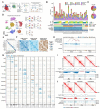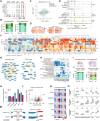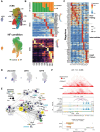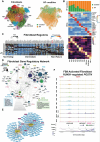This is a preprint.
Single cell multiomics and 3D genome architecture reveal novel pathways of human heart failure
- PMID: 40385400
- PMCID: PMC12083629
- DOI: 10.1101/2025.05.08.25327176
Single cell multiomics and 3D genome architecture reveal novel pathways of human heart failure
Abstract
Heart failure is a leading cause of morbidity and mortality; yet gene regulatory mechanisms driving cell type-specific pathologic responses remain undefined. Here, we present the cell type-resolved transcriptomes, chromatin accessibility, histone modifications and chromatin organization of 36 non-failing and failing human hearts profiled from 776,479 cells spanning all cardiac chambers. Integrative analyses revealed dynamic changes in cell type composition, gene regulatory programs and chromatin organization, which expanded the annotation of cardiac cis-regulatory sequences by ten-fold and mapped cell type-specific enhancer-gene interactions. Cardiomyocytes and fibroblasts particularly exhibited complex disease-associated cellular states, gene regulatory programs and global chromatin reorganization. Mapping genetic association data onto cell type-specific regulatory programs revealed likely causal genetic contributors to heart failure. Together, these findings provide comprehensive, multimodal gene regulatory maps of the human heart in health and disease, offering a valuable framework for designing precise cell type-targeted therapies for treating heart failure.
Conflict of interest statement
Competing interests: The following authors declare competing interests. Consultancy fees: SGD (Abbott), KJG (Genentech). KJG has received honoraria from Pfizer, holds stock in Neurocrine Biosciences, and his spouse is employed at Altos Labs. SGD acknowledges research support from Novartis. RME is an employee and shareholder of Pfizer. BR is a shareholder and consultant of Arima Genomics Inc. and cofounder of Epigenome Technologies, Inc. All other authors declare no competing interests.
Figures






References
-
- Khan M. S., Shahid I., Bennis A., Rakisheva A., Metra M., Butler J., Global epidemiology of heart failure. Nat. Rev. Cardiol. 21 (2024), pp. 717–734. - PubMed
-
- Olivotto I., Udelson J. E., Pieroni M., Rapezzi C., Genetic causes of heart failure with preserved ejection fraction: emerging pharmacological treatments. Eur. Heart J. 44, 656–667 (2023). - PubMed
-
- Heymans S., Lakdawala N. K., Tschöpe C., Klingel K., Dilated cardiomyopathy: causes, mechanisms, and current and future treatment approaches. Lancet. 402 (2023), pp. 998–1011. - PubMed
-
- Arvanitis M., Tampakakis E., Zhang Y., Wang W., Auton A., Agee M., Aslibekyan S., Bell R. K., Bryc K., Clark S. K., Elson S. L., Fletez-Brant K., Fontanillas P., Furlotte N. A., Gandhi P. M., Heilbron K., Hicks B., Hinds D. A., Huber K. E., Jewett E. M., Jiang Y., Kleinman A., Lin K. H., Litterman N. K., McCreight J. C., McIntyre M. H., McManus K. F., Mountain J. L., Mozaffari S. V., Nandakumar P., Noblin E. S., Northover C. A. M., O’Connell J., Pitts S. J., Poznik G. D., Sathirapongsasuti J. F., Shastri A. J., Shelton J. F., Shringarpure S., Tian C., Tung J. Y., Tunney R. J., Vacic V., Wang X., Zare A. S., Dutta D., Glavaris S., Keramati A., Chatterjee N., Chi N. C., Ren B., Post W. S., Battle A., Genome-wide association and multi-omic analyses reveal ACTN2 as a gene linked to heart failure. Nat. Commun. 11 (2020), doi:10.1038/s41467-020-14843-7. - DOI - PMC - PubMed
Publication types
Grants and funding
LinkOut - more resources
Full Text Sources
